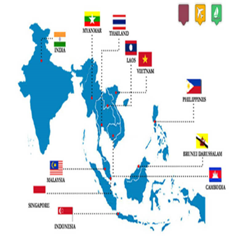TAG: GS: 2- IR
CONTEXT: India and ASEAN countries regularly hold summits to discuss various bilateral issues such as trade, security, and regional cooperation. The latest summit, typically held around this time of year (2024), could bring new agreements or policy discussions to the forefront.
EXPLANATION:
What is Act East Policy:
The ‘Act East Policy’ announced in November 2014 is the upgrade of the “Look East Policy”. It is a diplomatic initiative to promote economic, strategic and cultural relations with the vast Asia-Pacific region at different levels.
-
- It involves intensive and continuous engagement with Southeast Asian countries in the field of connectivity, trade, culture, defence and people-to-people-contact at bilateral, regional and multilateral levels.
- Aim:
- To promote economic cooperation, cultural ties and developing a strategic relationship with countries in Indo-pacific region with a proactive and pragmatic approach and thereby improving the economic development of the North Eastern Region (NER) which is a gateway to the South East Asia Region.

What is the Look East Policy:
- In order to recover from the loss of the strategic partner -USSR (end of the Cold war 1991), India sought to build up a relationship with the USA and allies of the USA in Southeast Asia.
- In this pursuit, former Prime minister of India P V Narasimha Rao launched Look East policy in 1992, to give a strategic push to India’s engagement with the South-East Asia region, to bolster its standing as a regional power and a counterweight to the strategic influence of the People’s Republic of China.
What is the Difference Between Look East Policy and Act East Policy:
| Look East Policy | Act East Policy |
o India became a dialogue partner of ASEAN in 1996 and summit level partner in 2002. o In 2012 the relationship got up-graded into a Strategic Partnership. o The time when India launched the Look East Policy in 1992, India’s trade with ASEAN was USD 2 billion. After signing the Free Trade Agreement in 2010 with ASEAN, the trade has grown to USD 72 billion (2017-18). o India is also an active participant in several regional forums like the East Asia Summit (EAS), ASEAN Regional Forum (ARF) etc. |
|
What are the Initiatives to Enhance Connectivity under Act East Policy:
- Agartala-Akhaura Rail Link between India and Bangladesh.
- Intermodal transport linkages and inland waterways through Bangladesh.
- Kaladan Multimodal Transit Transport Project and the Trilateral Highway Project connecting the Northeast with Myanmar and Thailand.
- Under India-Japan Act East Forum, projects such as Road and Bridges and modernization of Hydro-electric power projects have been undertaken.
- India-Japan Act East Forum was established in 2017 which aims to provide a platform for India-Japan collaboration under the rubric of India’s “Act East Policy” and Japan’s “Free and Open Indo-Pacific Strategy”.
- The Forum will identify specific projects for economic modernization of India’s North-East region including those pertaining to connectivity, developmental infrastructure, industrial linkages as well as people-to-people contacts through tourism, culture and sports-related activities.
India roles:
- India is also implementing Quick Impact Projects in Cambodia, Laos, Myanmar and Vietnam to provide development assistance to grass-root level communities in the fields of education, water resources, health etc.
- To enhance the modal share of coastal shipping and inland water transport, 46 initiatives have been identified in Amrit Kaal Vision 2047.
- The plan also aims to operationalize 50 waterways by 2047 and introduce low-draft vessel designs with possible tug-barge combinations to enhance efficiency and accessibility.
Source:
Spread the Word
